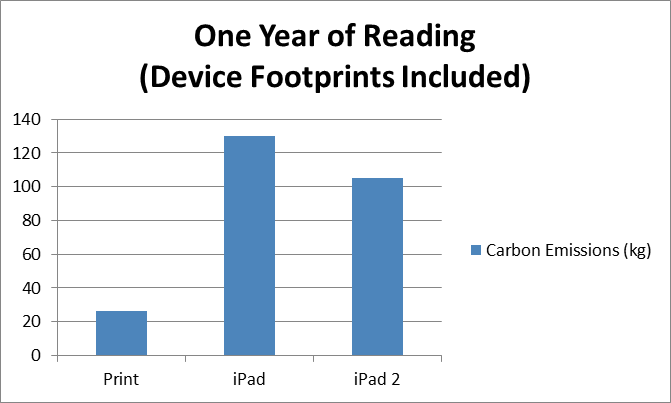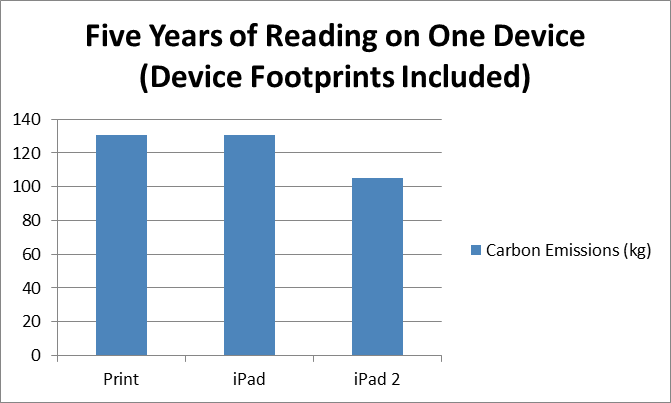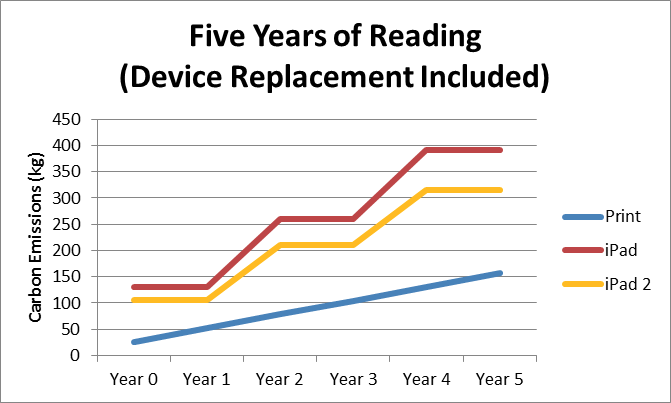
1.
In 2009, the Book Industry Environmental Council set a couple of environmental goals for the U.S. book industry. Using a calculation of the industry’s total greenhouse gas emissions from 2006 as its baseline, the BIEC and its members pledged to reduce the industry’s carbon footprint by 20% in 2020 and by 80% in 2050. When the pledge was made, the Kindle had existed for only a year and a half, and the Nook was still eight months away. (Kobo eReaders and iPads didn’t emerge until 2010.) eBooks, still in their infancy, accounted for a measly 5% of books sold in America.
Today, it seems like many publishing houses are on their ways toward achieving the BIEC goals. Thanks to the proliferation of FTP software, most major publishing houses have slashed the amount of printing done in-office. At John Wiley & Sons, my production group had a paperless workflow: Adobe was our editing tool of choice, and to be one of our freelancers, you had to pass an exhaustive MS Word screening test. Later on, at Oxford University Press, a common email signature asked readers to “save paper and print only what’s necessary.” Organizing stacks of paper on your desk was out; navigating sub-folders on a shared drive was in.
Meanwhile eBooks were becoming ever more popular. By the end of 2011, Amazon announced it was selling one million Kindles a week, and Apple said it had sold over 40 million iPads. Consequently, eBooks accounted for 31% of U.S. book sales by 2012. According to a Pew Internet study, as many as one in four American adults now own an eReader or tablet (one in three if they went to college). The trend toward digitization is undeniable, and there are many reasons to be optimistic: big publishers are making more money off of more products than ever before; it’s easier than ever to publish a book; and the number of books available to anyone with an internet connection is unprecedented. Some analysts even predict that soon print books, like CDs a few years ago, will be almost entirely replaced by digital files.
But is all of this really cutting the industry’s carbon footprint? Is total eBook adoption — that is: elimination of the print book — really an ecologically responsible goal?
2.
Put in absolute terms, the number of books — regardless of format — produced and sold across the globe increases each year. This is mostly due to an increasing global population. While America, Australia, India and the UK are the most rapid adopters of digital reading devices — at least for the time being — eBooks presently account for only a small fraction of the world book market. (This is due to factors such as availability of technology, reliable internet connections, and disposable income.)
Necessarily, the increased consumption of print and digital books has led to an ever-increasing demand for the materials required to create, transport, and store them. In the case of eBooks, though, vast amounts of materials are also necessary for the eReaders themselves, and this is something typically overlooked by proponents of digitization: the material costs are either ignored, or, more misleadingly, they’re classified as the byproduct of the tech industry instead of the book industry.
National Geographic correspondent Allen Tellis recently posted a brief note of encouragement to owners of eReaders, and it illustrates exactly the type of oversight I just mentioned. “The steady rise of eBooks,” Tellis wrote, “should benefit the environment by reducing use of paper and ink, and by slashing transportation, warehouse, and shelf-space limits.” He went on to note how certain study groups have determined “that the carbon released from eBooks is offset after people read more than 14 eBooks” on a single eReader. But Tellis ignores the fact that global print book consumption is rising concurrently with eBook consumption. In other words: the carbon footprint of the digital book industry is mostly growing in addition to, not to the detriment of, the growing carbon footprint of the print book industry.
I couldn’t locate the source of Tellis’ information about those 14 eBooks offsetting the ecological cost of their owner’s eReader. Instead, I found this New York Times op-ed which painted a starkly different picture: “the impact of one e-reader … equals roughly 40 to 50 books. When it comes to global warming, though, it’s 100 books.” Still more damning, Ted Genoways’ excellent VQR article about the raw materials needed for the production of eReaders (and other gizmos), found that:
At present, the average e-reader is used less than two years before it is replaced. That means that the nearly ten million e-readers expected to be in use by next year would have to supplant the sales of 250 million new books — not used or rare editions, 250 million new books — each year just to come out footprint-neutral. Considering the fact that the Association of American Publishers estimates that the combined sales of all books in America (adult books, children’s books, textbooks, and religious works) amounted to fewer than 25 million copies last year, we have already increased the environmental impact of reading by tenfold. Moreover, it takes almost exactly fifty times as much fossil fuel production to power an iPad for the hours it takes to read a book as it would take to read the same book on paper by electric light.
3.
Usage figures are an important element in the estimation of a book’s environmental impact. According to Apple, an iPad is responsible for 2.5 grams of CO2e per hour of use. A single print book, on the other hand, is responsible for “a net 8.85 pounds” (PDF) of carbon emissions over the course of its life (e.g. production, transportation, and retail). Note that the former figure, however, is open-ended; the latter figure is finite. If you ignore the environmental cost of an eReader, that means you would need to read the iBookstore version of War and Peace for 1,605.39 hours (~67 days) to damage the environment as badly as that paperback copy of Tolstoy’s tome on your bookshelf. That certainly sounds like a point for eBooks, but it’s a totally misleading evaluation.
For a demonstration of just how misleading that comparison is, I used basic arithmetic and some minimal Googling to calculate the carbon footprint of the average American reading an average number of average novels at an average speed both in print and on an iPad. (I picked iPads because Amazon doesn’t release Kindle data. I picked America because we’re the most voracious consumers of digital books.) Here’s what I found:
I. One Year of Reading:
First I calculated the average rate of consumption for the average reader. I found average reading speed, average book length, and average number of books consumed, and then I calculated the carbon emissions caused by one year of reading.

- The average adult reads 200-250 words per minute. (Source)
- The average novel is 64,500 words. (Source)
- That means the average adult spends 4.3 hours reading an average novel.
[(64,500 words / 250 wpm) / 60 minutes] - The average adult reads 6.5 books per year. (Source; PDF)
- The average adult spends 27.95 hours reading each year.
[6.5 books * 4.3 hours]
Paperback Footprint: 26,087.59 grams of CO2e
[6.5 books * 8.85 pounds of emissions * 453.5 g. per lb.]
eBook Footprint: 69.875 grams of CO2e
[6.5 books * 4.3 hours * 2.5 g. of emissions per hr.]
This is the comparison eBook proponents typically cite. Unfortunately, it’s at best lousy mathematics and at worst a manipulative comparison.
II. One Year of Reading (Device Footprints Included):
Next I found the lifetime carbon emissions from one iPad and one iPad 2, and I plugged those into my one year of reading calculations.

iPad lifetime emissions: 130,000 grams of CO2e (Source; PDF)
iPad 2 lifetime emissions: 105,000 grams of CO2e (Source; PDF)
Paperback Footprint: 26,087.59 grams of CO2e
eBook Footprint (iPad): 130,069.875 grams of CO2e
eBook Footprint (iPad 2): 105,069.875 grams of CO2e
As you can plainly see, factoring in the carbon footprint of an eReader drastically changes the comparison. One year of reading eBooks accounts for a carbon footprint five times greater than a year’s worth of print books.
Fans of eReaders will of course refute this data by claiming that their devices level out with — and could even become “greener” than — print books on a long enough timeline. This claim is indeed theoretically true after five years, and I’ll show you how.
III. Five Years of Reading on One Device (Device Footprints Included):
I extrapolated the data to account for five years of use at the same rate of consumption as above. (And on the same device for all five years — more on that in a minute.)

Paperback Footprint: 130,437.95 grams of CO2e
eBook Footprint (iPad): 130,349.375 grams of CO2e
eBook Footprint (iPad 2): 105,349.375 grams of CO2e
I determined that it takes five years (32.5 books) of steady eBook consumption (on the same device) to match the ecological footprint of reading the same number of print books the old fashioned way. This number is smack in between Tellis’ (14 books) and The New York Times’ (50 books) calculations. However it, too, is misleading because it doesn’t correctly account for device replacement.
As Ted Genoways was saying, most eReaders are used for only two years before being discarded, replaced, lost or broken. More than 20% of all Kindles sit unused after Christmas. So, that in mind, let’s look at the numbers when we factor in average eReader use — and account for device replacement every two years.
IV. Five Years of Reading (Device Replacement Included):
Assuming a device is replaced every two years (years 0, 2, and 4), this is the most accurate depiction of how an eReader compares to a pile of print books.

That eReader, then, accounts for an initial carbon footprint 200-250% greater than your typical household library, and it increases every time you get a new eReader for Christmas, or every time the latest Apple Keynote lights a fire in your wallet.
Also, these figures simply calculate the impact one person’s consumption has on the environment. If you live in a household with multiple eReaders — say, one for your husband and one for your daughter, too — your family’s carbon emissions are more than 600-750% higher per year than they would be if you invested in a bunch of bookshelves or, better yet, a library card.
4.
Things are trickier than they seem, too. The truth is that the dedicated eReader died almost as soon as it arrived, and it’s since been replaced by items even worse for the environment than its ancestors. What we presently refer to as eReaders are more like all-purpose tablets equipped with email clients, web browsers, games, movie players, and more. (Even one of the earliest generations of Kindles offered a prototype web browser — buried in subfolders within the device’s navigation system, though clearly a hint of what was coming.) As these devices become more sophisticated, they invite more prolonged usage, so those 2.5 g of emissions per hour of use continue to add up. Likewise, as these devices become more sophisticated, their manufacture demands more precious materials — often from Southeast Asia, Africa, and South America.
Still more problematic is the fact that outdated devices are too often discarded inappropriately. You don’t need to investigate very hard to find evidence of the toll this mineral mining and e-waste dumping takes on fragile ecosystems.
The emissions and e-waste numbers could be stretched even further if I went down the resource rabbit hole to factor in: electricity needed at the Amazon and Apple data centers; communication infrastructure needed to transmit digital files across vast distances; the incessant need to recharge or replace the batteries of eReaders; the resources needed to recycle a digital device (compared to how easy it is to pulp or recycle a book); the packaging and physical mailing of digital devices; the need to replace a device when it breaks (instead of replacing a book when it’s lost); the fact that every reader of eBooks requires his or her own eReading device (whereas print books can be loaned out as needed from a library); the fact that most digital devices are manufactured abroad (and therefore transported across oceans); and etc…
This is the ultimate result of our culture’s fetishization of technology — a problem which will assuredly worsen before it improves. It wasn’t long ago that sophisticated electronics were few and far between. I grew up in a house with one desktop computer, and it was located in the kitchen. That was eleven years ago, and when I remember all the times I argued with my brother over who got to play StarCraft, my memory seems as quaint and outdated as a scene from Mad Men. Today, my thirteen-year-old sister has her own laptop, smartphone, and television to supplement the two desktop computers, additional television set, and Kindle Fire located in my mother’s home.
There’s an Apple store in Grand Central Station that I pass each day on my way to work; every morning I watch hundreds of commuters browse iPads as though they were magazines or candy. In the end, this conspicuous (and often unnecessary) tech consumption — eReaders included — contributes to an inflating carbon footprint far beyond anything ever caused by traditional book production.
5.
Of course, it’s slippery ethics to rationalize the book industry’s carbon footprint by focusing, instead, on the larger problem of the tech industry’s carbon footprint. Both are problems that need to be addressed. But for right now, if we’re forced to choose, the traditional paper route is the better one. If you worry for the future of our rainforests, and if you worry for the future of our planet, the responsible decision is to purchase or borrow books printed on recycled paper and from ecologically conscious vendors. (You can find a handy list of such places and printers here.)
While this tactic alone will not solve the problem, it will certainly make a difference if enough people choose library cards instead of Kindle Singles. And while it’s true that, now that digital has arrived, digital is here to stay, the book reading community needs to ask itself which is more important: developing a greener way to produce print books while we halt the growth of eBooks’ market share, committing fully to the creation of “greener” eReading devices — or some combination of both. Doing neither is not an option.
Raz Godelnik, CEO of Eco-Libris, estimates that 80% of a paperback book’s carbon footprint is caused by the earliest stages in its production process: paper harvesting, forest clearing, and material shipping. The BIEC recognized this, and one of its chief aims was to work on a more eco-friendly means of producing books. As consumers, though, we also have the power to fix this by demanding an even more responsible method of production from the largest publishing houses and their contractors. (This means we’d have to pay more for the end product, of course.) We must also demand better accountability from the technology companies that create eReaders, and that begins with demanding Amazon release better information about the Kindle.
Consumer outcry works: a few months ago, because everyone flipped out about the mistreatment of Foxconn workers, Apple instituted major changes to the pay structure for their subcontractors. If we can do this with labor, we can do this with resources.
We must also resist the urge to purchase the next hot technology when it comes out. If you have an eReader, use your eReader until it no longer works, and then recycle it responsibly. Do not purchase a new one before the old one has stopped working. If you own an eReader that you do not use, sell it to someone who will actually use it so that they don’t have to buy a fresh one. In simple terms: you wouldn’t buy a new edition of a book if nothing was wrong with the edition you already owned, so why would you do it with something ecologically equal to fifty of those books put together?
Image via Wikimedia Commons








